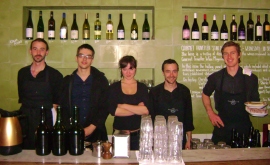
Don’t worry. Covering your eyes isn’t necessary when blind tasting.
How cool is it when someone can tell what wine they are drinking just by swirling, sniffing and sipping it? At the beginning of my career I was wowed by someone with this skill, and I have been developing it myself ever since. If you want to impress your friends or just get a kick out of drinking blind, then this is my advice to you
1. Build a collection of wines
Start buying wine made from popular grape varieties that come from regions with a reputation for making them well. Buy quite a few bottles, and get them far enough in advance that you can forget what you bought. Another option is to get a mixed case, available from most wine shops, online and otherwise. Alternatively you could ask a wine shop assistant to secretly pick a few bottles for you. Just make sure that they are clear on your tasting objective and budget.
2. Get a private wine waiter (or a drinking buddy)
You will need a get a friend to pick a wine from your collection and pour it into a tasting glass, out of your sight. The bottle shape and closure (cork, screw top) can give away almost as much information as the label does, so be true to your senses and don’t peek.
3. Write notes
Writing notes allows you see how different brands made from the same grape variety have similar tastes, aromas, and textures in your mouth. Pretty soon you’ll be able to recognise some wine varieties without your notes. You can jot your notes any way you want to, but for consistency I recommend using the The Court of Master Sommeliers Tasting Grids, The Wine & Spirit Education Trust’s Systematic Approach to Tasting, or the chart below from bettertastingwine.com
4. Decode your notes
Every grape variety has some tell-tale characteristics no matter where the grapes were grown. Check a website to see if your findings correlate with what flavours and aromas this type of wine usually has.
5. Recognise your wins and learn from your losses
If you taste grapefruit when you should taste lemon, or if you smell apple when you should smell pear, count it as a win. No one’s palate is the same, and if you’re finding features from the same aroma families then you are doing well.
Where the grape is grown also affects the wine. But that is a blog post for another day. At this stage start making yourself aware of regions and wines that go hand-in-hand, but don’t beat yourself up if you can’t taste the difference between a sauvignon blanc from New Zealand or Chile. Be please that you can identify the variety, and know that NZ and Chile both produce great examples.
It is a great feeling when you have identified a wine correctly, but there is a lot to learn from what you get wrong, too. Don’t give up, just keep thinking while you’re drinking.

Do you need a little help choosing? Wine shop staff can be an invaluable source of information and suggestions.
Below are some suggestions to kick-off your blind tasting wine collection. These are examples of popular grape varieties from regions or countries that do them well:
Riesling: Germany, New Zealand, Alsace (FR), Clare Valley/Eden Valley (AU), New York (US), Canada
Chardonnay: Chablis / Burgundy (FR), Yarra Valley / Margaret River (AU), California (US), New Zealand
Sauvignon Blanc: Bordeaux / Sancerre / Pouilly-Fume (FR), New Zealand, Chile, South Africa
Pinot Noir: Burgundy (FR), Oregon (US), New Zealand, Canada, Victoria Australia
Cabernet Sauvignon / Merlot (These two grapes are commonly blended together): Bordeaux (FR), California (US), Chile, Coonawarra (AU), Argentina, South Africa
Don’t let this limit you though. There are plenty of grapes that display their traditional characteristics intensely. Try Viognier, Gewürztraminer, Beaujolais, Temprenillo (Rioja, SP), Nebbiolo (Barolo, Barbaresco, IT), or Torrontés and Malbec from Argentina.
Click for Seven more tips on training your palate, or for advice on setting up the best wine tasting environment.
Be sure to share if found this post helpful or if you have any questions.
